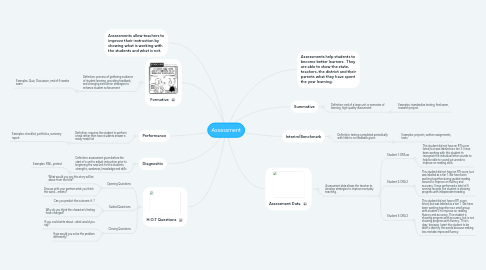
1. Formative
1.1. Definition: process of gathering evidence of student learning, providing feedback, and changing instruction strategies to enhance student achievement
1.1.1. Examples: Quiz, Discussion, end of 6-weeks exam
2. Performance
2.1. Definition: requires the student to perform a task rather than have students answer a ready-made list
2.1.1. Examples: checklist, portfolios, summary report
3. Diagnositic
3.1. Definition: assessment given before the start of a unit to adjust instruction prior to beginning the new unit for the students strengths, weakness, knowledge and skills
3.1.1. Examples: KWL, pretest
4. Assessments allow teachers to improve their instruction by showing what is working with the students and what is not.
5. H.O.T Questions
5.1. Opening Questions
5.1.1. What would you say this story will be about from the title?
5.1.2. Discuss with your partner what you think the word.....means?
5.2. Guided Questions
5.2.1. Can you predict the outcome if...?
5.2.2. Why do you think the character's feeling have changed?
5.3. Closing Questions
5.3.1. If you could write about....what would you say?
5.3.2. How would you solve the problem differently?
6. Interim/Benchmark
6.1. Definition: testing completed periodically with little to no feedback given
6.1.1. Examples: projects, written assignments, tests
7. Summative
7.1. Definition: end of a large unit or semester of learning, high-quality assessment
7.1.1. Examples: standardize testing, final exam, research project
8. Assessments help students to become better learners. They are able to show the state, teachers, the district and their parents what they have spent the year learning.
9. Assessment Data
9.1. Assessment data allows the teacher to develop strategies to improve everyday teaching.
9.1.1. Student 1: DRA aa
9.1.1.1. This student did not have an RTI score listed, but was labeled as a tier 3. I have been working with this student to recognize the individual letter sounds to help be able to sound out words to improve on reading skills.
9.1.2. Student 2: DRA 2
9.1.2.1. This student did not have an RTI score, but was labeled as a tier 1. We have been working together during guided reading lessons to improve on fluency and accuracy. I have performed a total of 6 running records, the student is showing progress with independent reading.
9.1.3. Student 3: DRA 2
9.1.3.1. This student did not have a RTI score listed, but was labeled as a tier 1. We have been working together as a small group with student 2 to improve on reading fluency and accuracy. This student is showing progress with accuracy, but is not showing progress with fluency. This is okay, because I want the student to be able to identify the words because making less mistake improved fluency.

